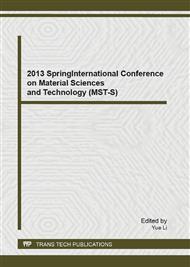[1]
Yingliang Tian, Shibing Sun, New Glass Technology, Beijing, Light industry press, 2009:123-128.
Google Scholar
[2]
Samoteikin, Gladushko, OA, Specifics of electrical conduction in alkali-silicate glasses, Glass and Ceramics, 59(2002) 8-10.
Google Scholar
[3]
Adam Ellison, Iván A. Cornejo, Glass substrates for liquid crystal displays .International Journal of Applied Glass Science, 1(2010) 87-103.
DOI: 10.1111/j.2041-1294.2010.00009.x
Google Scholar
[4]
Kim, Kwang-Ryul; Yi, Junsin; Cho, Sung-Hak; Kang, Nam-Hyun; Cho, Myung-Woo; Shin, Bo-Sung; Choi, Byoungdeog. SLM-based maskless lithography for TFT-LCD. Applied Surface Science, 255(2009)7835-7840 .
DOI: 10.1016/j.apsusc.2009.05.022
Google Scholar
[5]
ArunK.Varshneya, Fundamentals of inorganic glasses, Academic Press, Inc, New York , 1994.
Google Scholar
[6]
Gang Zhang, The research on clarification of aluminosiliate glass. Masteral, Dissertation of Beijing University of Technology, 2010,1-6.
Google Scholar
[7]
J. Stanek. Electric Melting of Glass, Elsevier Scientific Publishing Company, New.York: Amsterdam. Oxford,1977.30-31.
Google Scholar
[8]
Jinfang Chen, Glass electric oven technology, Chemical industry press. 2007, 279-299.
Google Scholar
[9]
Solvang, M; Yue, YZ; Jensen, SL.The effects of Mg-Ca and Fe-Mg substitution on rheological and thermodynamic properties of aluminosilicate melts, Journal of Non-Crystalline Solids, 345(2004)782-786.
DOI: 10.1016/j.jnoncrysol.2004.08.201
Google Scholar
[10]
Kamada, K; Tsutsumi, Y; Yamashita, S; Matsumoto, Y, Selective substitution of alkali cations in mixed alkali glass by solid-state electrochemistry, Journal of SolidState Chemistry.177(2004) 189- 193.
DOI: 10.1016/s0022-4596(03)00399-2
Google Scholar
[11]
Paramesh G.; Vaish Rahul; Varma K. B. R, Electrical transport properties of 0.5Li2O-0.5M2O-2B2O3 (M = Li, Na and K) glasses, Journal of Non-Crystalline Solids, 357(2011) 1479- 1484.
DOI: 10.1016/j.jnoncrysol.2010.12.037
Google Scholar
[12]
Prieto-Blanco Xesus, Electro-diffusion equations of monovalent cations in glass under charge neutrality approximation for optical waveguide fabrication, Optical Materials, 31(2008) 418-428.
DOI: 10.1016/j.optmat.2008.06.004
Google Scholar
[13]
Darwish H; Gomaa MM, Effect of compositional changes on the structure and properties of alkali-alumino borosilicate glasses, Journal of Materials Science-Materials In Electronics, 17 (2006) 35-42.
DOI: 10.1007/s10854-005-5139-2
Google Scholar
[14]
Katsumata, T; Suzuki, N ; Saito, N; Shibasaki, M; Matsuo, T, Proceedings of 12th International Symposium on Molten Salts, Electrical conductivity and nuclear magnetic resonance of molten lithium borates.Edited by: Trulove, PC; Electrochemical Society Series, 99 (2000) 383-391.
DOI: 10.1149/199941.0383pv
Google Scholar


